Virginia McIntosh from APS Central Coast Group reports on creating a garden at Phillip House, Kariong. Virginia was the coordinator of the working bee.
You want us to plant a native garden? Oh YES!
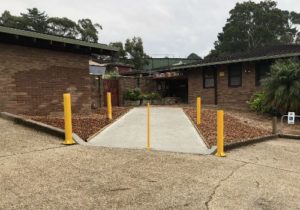
And the story goes…
Kerry, a Rotary member and manager of Phillip House Kariong, approached us, APS Central Coast, to plant a native garden at the entrance to the building. We were more than happy to oblige as we hold our meetings there and who doesn’t love to plant natives!! The entrance had recently been remodelled to accommodate disabled people.
The working bee
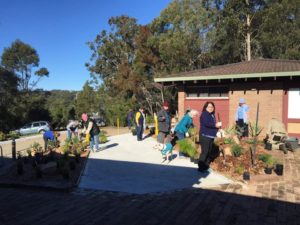
After some discussion re design, time to plant and creating a list of suitable plants, we formed a working bee for Saturday 13 July 2019. We timed it nicely to fit in with a sausage sizzle lunch happily and kindly provided by Rotary. Thank you Kerry and mates! And after lunch we had our monthly meeting. A long but enjoyable day.
As the area had already been mulched, the day began with Jonathan Steeds and Olga Blacha from Sustainable Natives delivering some decent sized rocks kindly donated by Steve Jones from Grants Road Sands in Somersby. With great dexterity Jonathan rolled these off his truck and man-handled them into position! No injuries….phew!
The plants
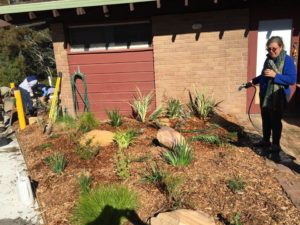
Then came the planting. Sustainable Natives van’s doors opened to reveal a treasure trove of goodies ……oooh how exciting! All donated by Sustainable Natives – fantastic! Here is the list:
Dianella ‘Silver Streak’ and caerulea; Lomandra ‘Little Con’, ‘Little Pat’ and ‘LimeTuff’; Grevillea ‘Dorothy Gordon’; Banksia integrifolia ‘prostrate form’, oblongifolia, ericifolia, ‘Little Eric’,and spinulosa; Veronica perfoliata; Melaleuca ‘Ulladulla Beacon’ and hypericifolia; Correa reflexa; Darwinia fascicularis; Chorizema cordatum; Scaevola ‘Mauve Cluster’; Leptospermum ’Vertical Drop’; Dwarf Leucopogon; Micromyrtus ciliata; Thryptomene P.C.Payne; Grevillea oldeii, humilis, ‘Pink Gem’, speciosa X and sericea; Patersonia occidentalis; Anigozanthos ‘Big Red’ and ‘Pink Pearl’; Acacia howittii dwarf; Westringia ‘Smokey’; Prostanthera incisa and magnifica; Podocarpus spinulosus; Pycnosorus globosus; Isopogon anethifolius dwarf; Petrophile pulchella; Goodenia mcmillanii; Callistemon ‘Rocky rambler’; Casuarina ‘Cousin It’.
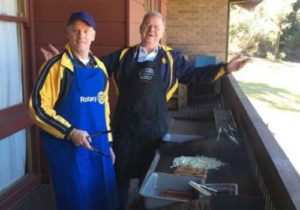
Hopefully I haven’t left any out – think I may have but just too many to remember! Anyway you get the drift.
A production line
Olga, being a landscape designer, and Jonathan had already laid the plants out ready for planting so we set up a production line of hole diggers, planters, waterers and pot collectors. After a final watering in, we left our little proteges while we gorged ourselves on sausage sandwiches!
Finishing up
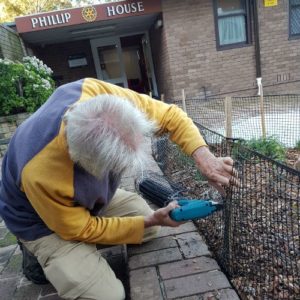
Fully satisfied we headed into our monthly meeting and left my husband, Stuart, to erect a ‘rabbit proof fence’ around the perimeters of the two gardens. Don’t worry, he didn’t mind – he usually falls asleep in meetings!
Protecting the new garden
Being on an eastern, gently sloping block with buildings uphill and thus to the west helps ensure plant survival. Rotary have taken on the responsibility of caring for the garden and each time we walk by we can enjoy the fruits of our labours and the benefits of Rotary’s maintenance. Hopefully others who use the path are suitably impressed and are converted by the beauty and resilience of Australian native plants. A win win all round!
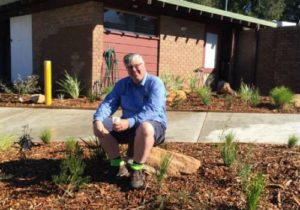
Do you like our garden gnome??!!
